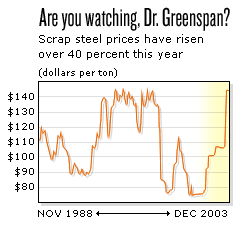NEW YORK (CNN/Money) - The Federal Reserve may not act worried about the prospect of a rise in inflation, but one of Fed Chairman Alan Greenspan's favorite economic indicators is flashing red.
The price of scrap steel, which has historically worked well as an indicator of where the economy is headed, has shot up more than 40 percent the past year and is now trading near highs not seen since the mid-1990s.

"Scrap has always been a good indicator, because it feeds directly into consumer spending and capital spending," said Don Fine, president of Fine Financial Forecasting. "If scrap steel is rising sharply, it's a good indication that things overall are picking up. It's an old, trusted standby and it should not be ignored."
As a private sector economist, Greenspan was well known for closely following scrap steel and indications are that his penchant for scrap has stayed with him during his tenure at the Fed.
"Every day, I still look for the price of No. 1 heavy melt steel scrap," Greenspan told the American Iron and Steel Institute's annual meeting in 1997.
Somewhere, Fred Sanford is smiling
Whether watching scrap is as worthwhile now as it used to be is unclear. In the past, a sharp rise in scrap steel prices indicated that U.S. manufacturing demand was rising sharply. But today much of the demand is coming from overseas.
"We've been exporting a lot on both coasts," said Marc Schupan, head of Kalamazoo, Mich.-based recycling and metals firm Schupan & Sons. This has left scrap steel inventories incredibly light, fueling sharp rises in price.
Growing at a breakneck pace, China's appetite for the steel it needs to fuel manufacturing is voracious.
The value of U.S. "ferrous waste and scrap" exports to China in the third quarter rose by more than 80 percent over the third quarter of last year, according to the Commerce Department. Schnitzer Steel, a major scrap metal player, said that it exported 373,000 tons of ferrous metal in its quarter ended Aug. 31, a 40 percent increase from what it shipped in the same period last year. Again, demand from China was the major factor.
It's not just rising demand that's pushing scrap steel prices higher, points out Bernard Lashinsky, an economist who consults for the steel industry, but constraints on supply.
Overall, the U.S. iron and steel industry has added very little manufacturing capacity over the past twenty years, according to Federal Reserve statistics. During that time there's been an internal shift in the steel industry from blast furnace operations, which process iron ore, to electric furnaces, whose feed stock is scrap.
"You can't increase the stock of steel goods by recycling," said Lashinsky. And scrap exports -- though some return in the form of finished goods -- deplete the stock of steel further. This leaves the United States with increased demand for a decreased commodity.
So the rise in scrap steel prices doesn't matter? Not so fast.
First off, scrap prices wouldn't be running higher if there wasn't something going on in the economy. While noting that there do appear to be special factors behind scrap's rise, Schupan also said that his customers "seem to be fairly busy."
YOUR E-MAIL ALERTS
|
Follow the news that matters to you. Create your own alert to be notified on topics you're interested in.
Or, visit Popular Alerts for suggestions.
|
|
|
 |
Second, constrained supply and increased demand from both home and abroad aren't sending just scrap steel prices higher. Raw material prices from cotton to copper, from soybean oil to crude oil, have been on an upswing.
"Everything is up but inflation," said Fine. "But trust me, inflation will follow."

|

